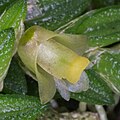| Image | Name | Distribution | Elevation (m) |
|---|
 | Dendrobium bowmanii Benth. 1873 | Australia (Queensland and New South Wales) and New Caledonia. | 0–200 metres (0–656 ft) |
| Dendrobium brevicaudum D.L.Jones & M.A.Clem. 1994 | Australia (Queensland) | 700–950 metres (2,300–3,120 ft) |
| Dendrobium casuarinae Schltr. 1918 | New Caledonia | 0–1,000 metres (0–3,281 ft) |
| Dendrobium caudiculatum M.A.Clem. & D.L.Jones 1996 | Papua New Guinea | 40–900 metres (130–2,950 ft) |
| Dendrobium chordiforme Kraenzl. 1910 | Papua New Guinea | 10–3,300 metres (33–10,827 ft) |
| Dendrobium contextum Schuit. & de Vogel ex J.M.H.Shaw 2003 | Papua New Guinea | 1,200 metres (3,900 ft) |
| Dendrobium crispatum (G.Forst.) Sw. 1799 | French Polynesia (Society Islands) | |
 | Dendrobium cucumerinum MacLeay ex Lindl. 1842 | Australia (Queensland) | 50–800 metres (160–2,620 ft) |
| Dendrobium erythraeum Schuit. & de Vogel 2003 | Papua New Guinea | |
| Dendrobium flagellum Schltr. 1912 | New Guinea | 150 metres (490 ft) |
| Dendrobium fuliginosum (M.A.Clem. & D.L.Jones) P.F.Hunt 1998 | New Guinea | |
| Dendrobium leptophyton Schuit. & de Vogel 2003 | Papua New Guinea | 900–2,000 metres (3,000–6,600 ft) |
 | Dendrobium lichenastrum (F.Muell.) Rolfe 1905 | Australia (Queensland) | 0–1,950 metres (0–6,398 ft) |
 | Dendrobium linguiforme Sw. 1800 | Australia (Queensland and New South Wales) | 0–1,200 metres (0–3,937 ft) |
| Dendrobium mortii F.Muell. 1859 | New Caledonia, Australia (Queensland and New South Wales) | 300–900 metres (980–2,950 ft) |
| Dendrobium nothofageti (M.A.Clem. & D.L.Jones) Schuit. & de Vogel 2003 | Papua New Guinea | 2,800 metres (9,200 ft) |
 | Dendrobium pugioniforme A.Cunn. ex Lindl. 1839 | Australia (Queensland and New South Wales) | 0–1,300 metres (0–4,265 ft) |
| Dendrobium racemosum (Nicholls) Clemesha & Dockrill 1964 | Australia (Queensland) | 800–1,500 metres (2,600–4,900 ft) |
| Dendrobium rigidum R.Br. 1810 | Australia(Queensland) and New Guinea | 700 metres (2,300 ft) |
 | Dendrobium schoeninum Lindl. 1846 | Australia (Queensland and New South Wales) | 600 metres (2,000 ft) |
 | Dendrobium striolatum Rchb.f. 1857 | Australia (New South Wales, Victoria and Tasmania) | 1,000 metres (3,300 ft) |
 | Dendrobium teretifolium R.Br. 1810 | Australia (Queensland and New South Wales) | 5–800 metres (16–2,625 ft) |
 | Dendrobium toressae (F.M.Bailey) Dockrill 1964 | Australia (Queensland) | 50–1,220 metres (160–4,000 ft) |
| Dendrobium vagans Schltr. 1911 | New Caledonia, Fiji, Samoa, Vanuatu and the Santa Cruz Islands | 0–1,300 metres (0–4,265 ft) |
 | Dendrobium wassellii S.T.Blake 1963 | Australia (Queensland) | 300 metres (980 ft) |
|










